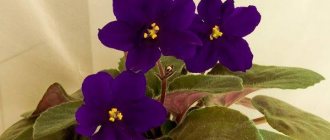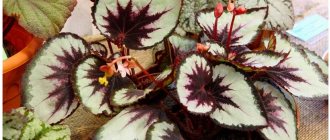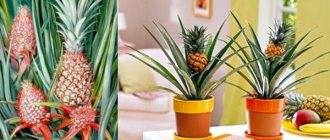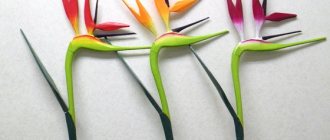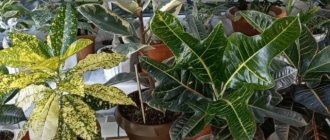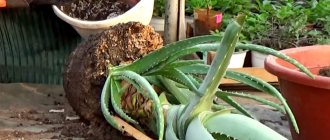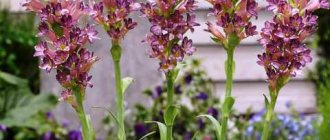Episcia is an exotic flower that belongs to the Gesneriev family. The plant's patterned, velvety foliage, framing bright flowers, has a glowing effect. There is a scientific explanation for the “magical” properties of the sparkling flower. The fibers of the leaves turn streams of light back to the source. In other words, the light is reflected back to the same point from which it came.
Dense foliage gives the plant a special attractiveness. As the old leaves dry out, many young shoots - children - appear at the base of the stem. It turns out that the outlandish foliage constantly frames the epicure.
What does it look like
Description
Episcia is valued for its foliage. It comes in a variety of colors: emerald, jade, bronze, copper, silver. The greenery shimmers with mother-of-pearl. In many species, a pattern is observed along the central region of the leaf.
Leaf plates have different shapes: round, oval, elliptical. Their surface can be smooth with shine or pubescent, similar to velvet. The edges are smooth and jagged.
A bell-shaped inflorescence on a short stalk with 5 petals. Blooms in July-September. The formation of fiery red buds occurs in single quantities or in bouquets. It has creeping shoots and tendrils, like strawberries. Thanks to them, the plant reproduces.
Domestic species
Not every plant variety was able to change its wild habitat to indoor conditions. Episcia has the following varieties that can be grown at home:
| Variety | Description |
| Copper. | Large view. With an oval plate that widens at the base. Brown-greenish foliage with a red tint turning into a copper color, velvety. A white vein is observed along the central zone of the leaf, creating contrast. The lower zone of the plate is reddish. The arrow on it is bright green. The greenery shimmers in the sunlight. The inflorescence is bright scarlet or fiery. The beginning of the petals is yellowish. Flowering is observed all summer. |
| Carnation flower. | Some experts classify this variety as a separate genus Alsobia. Like all species, it has antennae with daughter rosettes, short shoots, densely dotted with small leaves at the ends. The plate is dark green, almost black. There is a purple vein running down the middle. The flowers are white with red freckles at the base. The edge of their petals is fringed. |
| Creeping. | The name is due to its strong branching, forming a dense network of shoots. The variety has small leaves (length 9 cm, width 4-5 cm). The plate is olive-colored from the upper region, dull red below, covered with villi. The leaf shape is heart-shaped. Peduncles are purple. The petals are crimson on the inside, bloody on the outside. Flowering is observed from July to September. |
| Chocolate soldier. | Has thickened leaves. A network of veins is observed on the plates, making them voluminous and embossed. The foliage is green-purple. Flowering lasts for a long time. |
| Forest beauty. | The foliage has a silver-lavender hue with a bluish tint. Pastel pink flowers are observed in single quantities. They are small in size. |
| Northern lights. | The leaves have a unique combination of lilac-gold and dark green with a brown tint. The plates are pubescent, with cross veins. The petals are bright scarlet. |
| Silver glow. | The leaves are elongated, oval with pointed ends. Greens of a soft light green tone with a silvery mound. Rare flowers of a scarlet hue are observed between the leaves. |
| Blue Nile. | It is quite rare. Produces heavenly flowers with a lavender tint. Their middle is yellow. The foliage is brown-green with fluff. In the middle there is an olive-greenish stripe with middle veins. |
| Silver skies. | The rusty-red inflorescences contrast strongly against the background of silvery foliage. |
| Pink Panther. | Does not require special care, grows to large sizes. The flowers are large, bright strawberry. The foliage is green with a limestone, bronze tint. The plates can reach fifteen centimeters. |
| Pink akazhu. | The leaves are silver-green with snow-green stitches and splashes of pink. It blooms with reddish-red inflorescences with a yellowish core. |
| Tiger stripe. | Similar to tiger epic. A distinctive feature is the fine greenery with silvery veins. |
| Strawberry patch. | It has small leaves with pointed ends. The greens are bright, pinkish-red in tone. Scarlet buds with a lemon base. |
| Chocolate cream. | Silvery brown green with pinkish lines. The inflorescences are red. |
| Ronnie. | The buds are coral, the leaves are brown with silver-green veins. |
| Degas. | The leaves are brown-green with lines. The inflorescences are large and red. |
| Aloha Mauna Loa. | It is distinguished by quilted leaves similar to dark green velor. Reddish-red flowers. It is a hybrid bred specifically for home use. |
| Dutch. | The leaves are dark brown, velvety, medium in size. The light green, silvery pearlescent veins have a herringbone pattern. The inflorescence is red with a pinkish tint. |
Watercolor varieties are also bred at home. They are distinguished by an unusual foliage color and are not found in natural conditions. The following species are in demand among gardeners: Danae, Inessa, Black Queen, Strawberry mist (Strawberry mist) and Strawberry patch, Safari, TM-Sahara, Tiger stripe, Tricolor, Brown beauty, Panama white, Lilacina viridis, Sun Gold (Chimera), Dixie Dynamite, Smoky Topaz, Country Kitten, Coco, Gray Lady, Longwood, Sea Foam, Neptune, Silver Tire, Miniature Symphony (symphony), Seduction, Sports, Suomi, Helen Dixie.
Types and popular varieties
To date, breeders from different countries have developed many hybrid forms of Episcia, each of which is unique in its own way. At the same time, species of the genus Episcia, which are typical inhabitants of the tropics of Mexico, Brazil, and the Antilles, do not lose popularity in indoor plant growing.
Episcia copper (copper-red) or Episcia cupreata is one of the most famous “pure” species, which has won the sincere love of fans of exotic flora. This plant is still used today in breeding work, where it serves as the starting material for the creation of new interesting varieties.
A characteristic feature of this exotic is its dark foliage with a copper-red tint and a pale green pattern. During the flowering period, it forms a few single flowers of bright red color with a golden-yellow core.
Episcia repens is a herbaceous perennial native to Central and South America. The plant is notable for its long and creeping shoots, covered with pubescent foliage of an olive green hue with a dark red or dark brown edging. From mid-summer to early autumn, exotic flowers form single, small, scarlet flowers. In its natural habitat, this plant is capable of entwining tree trunks, easily clinging to them with long stems.
Episcia lilac is another native representative of the tropical flora, which has gained wide popularity among flower growers around the world. This species is characterized by carved, pubescent foliage of a dark emerald hue with pale green stripes decorating the center. This exotic plant becomes especially decorative during the flowering period, when it is covered with a few lilac-lilac flowers.
Episcia punctata, or Episcia punctata , is a rather rare species, found mainly in its natural habitat. The exotic beauty of this plant is emphasized not only by the thick, rich green foliage, but also by the unusual funnel-shaped flowers of white color with thick purple specks.
Episcia Tiger Stripe is a popular representative of home green collections, valued for its amazing decorative properties. The plant has pubescent ovate leaves of a dark emerald color with numerous pale green or gray-olive veins. During flowering, it is covered with single small scarlet flowers with a yellow core. When properly formed, it forms a compact and lush bush, but can take both cascading and ampelous forms.
Episcia watercolor is a whole group of representatives of the Gesneriaceae family, which are very popular among gardeners. A characteristic feature of these plants is the unusual color of the leaves, which is dominated by blurry pink-coral, peach, cream and soft emerald tones. The original coloring of the foliage resembles the arbitrary brush strokes of an artist, which is how these epics got their name.
“Rose Garden” is a very spectacular episcia, notable for the intricate coloring of its foliage. The leaves have a regular elliptical shape with a slightly pointed tip. The front side of the leaves is emerald green in color with a silver-olive stripe in the center and a crimson-red coating along the edges. A striking feature of the leaves is their pearlescent-glossy glow. The flowers are single, scarlet or juicy orange with a golden yellow center.
Episcia Temiscaming is an elegant indoor perennial, beloved by gardeners for its dense olive-green foliage with a silvery tint. Most often grown as an ampelous or semi-ampelous plant. During the flowering period, it forms small single flowers of a fiery red hue.
“Sea Foam”, or Sea Foam , is a varietal episcia, distinguished by its large size and impressive decorativeness. Thanks to the original color of the leaves, the plant looks great both during flowering and during dormancy. The large leaves in the central part are painted in a pale olive color, gradually turning into a deep ruby red at the edges. A pearlescent glossy glow gives the foliage a special charm.
“Emerald Velvet” is a luxurious variety with dense green pubescent foliage. The leaves are large, fleshy, with a random dark brown pattern. During the flowering period, it produces a few flowers of a soft lavender color with fine-toothed edges. The plant is considered quite whimsical, reacting painfully to non-compliance with maintenance rules.
“Strawberry Mist” is a spectacular episcia variety that is widely used in indoor floriculture. The plant is notable not only for its large ovoid leaves, but also for their amazing colors. The color of the leaves is crimson-red with a pale green pattern and dark ruby edging along the edges. The flowers can be pure bright orange or a mixed juicy orange with pale ruby strokes.
“Pink Panther” is a very decorative variety with large (up to 15 centimeters) leaves. The foliage color is uniform green with small bronze stripes or spots. The flowers are small, five-petaled, deep pink. The plant is most often grown as a semi-ampelic plant, but due to the elongated shoots it can also take a cascade form.
“Cheetah” is a relatively new variety of foreign selection, which has large quilted leaves of unusual colors. The color of the leaves is grassy-olive with dark cherry spots, merging along the edges into a continuous, uniform border. During the flowering period, it forms medium-sized single flowers of a rich orange-red color with a yellow core.
"Jim's Sea of Love" is a spectacular foreign variety that quickly became popular among gardeners. A characteristic feature of this plant is large elliptical leaves of pale or dark green color with a scattering of spots of dark wine or charcoal brown. With good care, the variety is able to delight its owner with small but very beautiful orange-scarlet flowers for a long time.
“Butternut” is an interesting episcia variety, characterized by its compactness and neat bush formation. The plant is notable for its even, ovate leaves of a lush green color in the center and a light raspberry-purple coating on the edges. The center of the leaves is decorated with an intricate pale green mesh. The foliage looks especially decorative due to its delicate glossy glow.
“Blue Nile” is a delightful episcia that can take on both a semi-ampelic, cascading and bush form. This variety is characterized by two-color leaves (soft green in the center with a transition to dark emerald at the edges), as well as a rare lilac-lavender color of the flowers. The core of the flowers is white, with a bright yellow center.
“Sun Gold” is another popular variety of foreign selection, which has gained wide popularity among gardeners for its unusual flower color. The flowers of this variety are characterized by a rich, juicy lemon hue with a narrow or wide white edge. The leaves are medium-sized, succulent, quilted. The foliage color is predominantly light or dark emerald with a pale green reticulate pattern.
“Pinkiscia” is a very decorative varietal episcia, forming a large rosette of green-bronze leaves with silver-olive veins. The originality of the bush is emphasized by the pearlescent gloss of the foliage and elongated side shoots. The flowers are small, solitary, juicy pink in color with a golden core. In indoor floriculture, it is usually grown as an hanging plant in hanging containers or flower pots.
"Chocolate Soldier" or "Chocolate Soldier" is an original compact variety with large fleshy leaves of unusual color. The foliage is a bronze-chocolate shade with an attractive pearlescent tint and a subtle pale olive pattern. The variety is considered to bloom profusely and for a long time. During the flowering period, the plant produces numerous small flowers of a soft scarlet color.
Dianthus
An ampelous plant with small, 3 cm long, velvety ellipsoidal leaves. The shade is bluish-green. It has 2 types of shoots: with short, closely spaced leaves, and with long thin tendrils with daughter rosettes. The flowers are white, solitary, with fringed edges. The plant blooms from June to September.
Home care
Epistomy care at home should be carried out according to all the rules:
| Factor | Recommendations |
| Location | Location matters when growing. It is recommended to place the pot on a windowsill on the north side. If this is done from the south, the plant moves a couple of meters from the window. When placing a flowerpot from the west or east, it is hung on the left or right side of the window sill. |
| Lighting | The light should be diffused. The plant does not like direct sunlight. In winter, additional lighting is needed to extend daylight hours by several hours. |
| Humidity | The minimum humidity level is 60%. To increase it, it is recommended to place containers with aqueous solutions or moss, expanded clay, coconut fiber, peat near the episcia, moistening them. If this is not enough, then the pot with the plant can be moved to the kitchen (there the air humidity is higher). Perform spraying and wiping. |
| Temperature | Episcia does not have a rest period. Feels comfortable at +22° to +26°C. In winter, the temperature can be lowered to +18°C. At +16° the flower dies. At +30° or more it will survive, but with proper watering. |
Pot, soil, replanting
The rhizomes of the flower are thin and fragile. They creep close to the ground surface. Therefore, for planting you need to choose a shallow pot or a wide bowl. The plant is planted in groups (three or more).
When growing a flower using the “carpet” method, you need to select a large pot so that there is enough space for the tendrils to grow. If planting is done in a hanging pot, then the container can be taken smaller: the mustache will hang down.
The soil is light, with medium acidity. The soil consists of leaf soil, peat and sand (3:1:1). Sphagnum and ash are added. Drainage is required: the bottom is lined with expanded clay or polystyrene foam (layer three centimeters).
The plant grows quickly; it is replanted once every twelve months. This happens as follows:
- episcia is watered and carefully removed from the pot;
- the root is inspected: dried and rotten areas are removed;
- a drainage layer of 3 cm is laid on the bottom, soil is poured on top;
- planting and watering are carried out.
The circumference of the pot for replanting should not exceed 20 cm.
How to transplant episcia
Hoya propagation by cuttings, rooting and replanting at home
With proper care, the episcia bush will grow quickly. And then there is a need to transplant into another pot. When to do it:
- young plant - once a year;
- adult plant - once every 2 years.
Seedling
The most suitable time is spring. To make the transplant procedure less painful, everything should be done carefully and according to plan.
- Moisten the soil in the pot generously.
- Tap the outside walls on the sides to loosen the lump.
- Remove the flower along with the soil.
- Remove diseased roots and shoots.
- Place in a new vessel, sprinkle with prepared soil.
- Water well.
- Place in the shade for a week.
When new shoots and flowers appear, this means that everything went well, so you can put the flowerpot in its original place.
Watering
Abundant watering is necessary from early spring to October, every other day. When watering, it is necessary to take into account the temperature and humidity of the air. In winter, you can carry out the manipulation less often: wait until the soil on top is completely dry. Any water that has drained into the pan must be poured out immediately. Excess moisture will destroy the plant, as will drying out.
The water is taken soft, settled for 2-3 days. Temperature - +28-+30ºС. Tap water is softened with lemon acid.
You need to make sure that the drops do not get on the greens: use a watering can with an elongated spout. Water is poured along the edges of the pots.
Top dressing
During active growth, fertilizing with organic or complex fertilizers for indoor flowers is recommended. They also use fertilizer for decorative foliage and flowering plants. You can buy it in a specialized store.
The dosage is indicated on the fertilizer packaging; it is reduced by 2-2.5 times.
Feeding is done twice a month. There is no need to fertilize the soil in autumn and winter. When the soil is dry, the event cannot be carried out: the roots can be burned.
Reproduction
Methods:
- seed;
- daughter sockets;
- side shoots;
- cuttings.
When propagated by seeds, the plant loses its varietal characteristics in 90% of cases. Planting is done in January or June in the surface layer of the earth, without sprinkling. Seeds require greenhouse conditions of +20ºС. The first shoots appear after 10-14 days. After a month they can be transplanted into separate containers.
When propagated by rosettes, without separating them from the adult episcia, they are buried in the soil and rooted. After this, the flower is placed in a new flowerpot or planted next to the mother plant. The roots appear after a week.
Carefully cut cuttings, pre-treated with Kornevin, are planted in previously prepared soil. Covered with glass. Within a few days the cuttings will take root.
Developed tendrils are cut from the mother plant. Each is divided into three parts and rooted in water. Next comes disembarkation.
How to care for a houseplant?
Lighting
Episcia is a plant that needs diffused light. Therefore, you should not leave it on southern windows, where the leaves may be exposed to direct sunlight. If there is no other option, then you should shade the flower from 10 a.m. to 2 p.m.
Northern windows are also not suitable for the plant: here it will lack light. During the period from mid-autumn to spring, when daylight hours are short, it is optimal to illuminate the episium with phytolamps or other devices.
Temperature
The flower feels great at room temperature. If indoors:
- below 16˚С - will die;
- 18-25˚С - normal growth and development;
- 25-35˚С - can exist with sufficient humidity;
- above 35˚С - it will die.
Watering
The plant needs abundant watering: the soil should not be allowed to dry out.
But you shouldn’t allow water to stagnate either. It is optimal to water when the top layer of soil dries out (about once every 2-3 days).
In winter, this should be done a little less often - once every 4-5 days. You need to use settled water at room temperature and do not allow water to get on the leaves - they will begin to rot.
Therefore, bottom watering will be more convenient. There is no need to spray the epicion.
Humidity
The flower needs high air humidity. Young plants are especially demanding of this parameter; after watering, they should be covered with film.
To ensure optimal conditions, you can place the pot with episcia in a tray with wet pebbles, expanded clay or sphagnum moss. In the case when the plant is suspended, the same materials must be placed in the gap between the flowerpot and the container with the flower.
How to fertilize?
Episcia needs fertilizer only during the period of active growth. Therefore, in spring and summer it should be fed once every two weeks in small doses. Mineral and organic fertilizers should be used in a concentration 50% lower than indicated in the recommendations. Suitable for flowers:
- during the flowering period - fertilizers for flowering plants (“Etisso”, “Compo Sana” “Florovit”);
- the rest of the time - complex mineral (“Hesi Phosphorus Plus”, “Agree’s”, “Multiflor Aqua”) or organic (bird droppings, compost, humus) fertilizers.
Trimming
Episcia grows very quickly, so to maintain the density and lushness of the plant, you need to resort to pruning.
- Creeping shoots should be removed regularly, otherwise the flower will grow and look untidy.
- It is necessary to cut off the escaped shoots with daughter rosettes, this will give the episcia a beautiful shape.
When forming the crown, you should not allow the shoots to hang from the pot: they will rub against its edge.
To avoid this, you can install a trellis 15-20 cm high and attach shoots to it as they grow. This will give the plant a beautiful shape.
Reproduction
Episcia can be propagated in four ways: seeds, cuttings, rosettes and leaves. Inexperienced gardeners are better off choosing one of the vegetative methods and not having to worry about germinating seeds. A mixture of soil and sand in a ratio of 3:1 is suitable for planting.
Seeds
With this method, you need to take into account that new plants do not retain the varietal characteristics of the parent, that is, the color of the leaves and the pattern on them can be anything. Seeds should be sown on a damp, disinfected substrate and, without covering with soil, covered with film. Ventilation is necessary once a day. Shoots will appear in 25-45 days.
Cuttings
A young shoot with three to four nodes is suitable for use as a cutting. Moreover, it should not have lateral processes. The cuttings can be placed in water until roots appear or immediately planted in a small pot. Then you need to cover it with film or a jar.
Rosettes
In spring, a young rosette of the first order with 4 developed leaves should be planted in a small container without cutting the tendril from the mother plant. There is no need to bury it - just bury the bend of the stem 2-3 cm. You can secure the rosette using a pin or a weight.
At first, the seedling needs greenhouse conditions. Within 7-10 days the rosette should take root, then the tendril can be cut off and transplanted to a permanent place.
Leaf
When using a leaf for propagation, you simply need to place it in water at room temperature. After 3-5 days the first roots will appear. Then you should plant it in a small pot.
It will take several months for new leaves to appear. In this case, the mother leaf will gradually wither and darken, giving strength to young shoots. You can’t tear it off, you have to wait until it falls off on its own.
Seedlings must be kept at a temperature of 23-24˚C and transplanted once a month into larger containers. The largest pot sufficient for an adult plant is 20 cm in diameter. The young flower should be carefully protected from the sun for a month.
Possible problems
When care errors occur, problems arise:
| Problem | What is the reason and how to eliminate it? |
| Brown spots of irregular shape form on greenery. | When watering, too cold water is used. It must be warmed up before the procedure. |
| The greenery turns yellow and falls off. | There is an excessive amount of nutrients in the soil: you need to fertilize the plant less often. The reason may lie in prolonged exposure to ultraviolet rays or too much watering. |
| The foliage is curled into a tube. | The flower is watered rarely, but abundantly. |
| The ends of the leaves become brown and dry out. | Lack of moisture in the air or ground. |
| The leaves fade, become dull, and become smaller. | The plant lacks light. It must be placed closer to the window or additional lamps must be used. |
| The greens are covered with a pale dirty or gray coating. | The flower does not have enough fresh air: the room needs to be ventilated regularly, or a transplant is necessary. |
| Doesn't bloom. | Episcia is watered very rarely, the soil has time to dry out. It may also be due to an excess of nitrogen in the soil, lack of fertilizer, dry or cold air. |
| Poor flowering, stretching of stems. | The plant does not have enough light. |
Why episcia does not bloom and other care problems
If the episcia does not bloom...
This means the following mistakes were made in care:
- Insufficient watering. The plant lacks moisture. The problem is possible even with daily watering - if the lump of earth is very compacted, water can go around the central part and spill into the pan. Make sure the soil in the pot is sufficiently permeable to moisture.
- Dry indoor air. As already noted, episcia loves high air humidity, so you need to take care of additional moisture near the plant.
- The plant is too cold. If the room temperature is below 18°C, the episcia will not bloom.
- Little light. With short daylight hours and minimal lighting, the episcia will experience discomfort and will not bloom.
- The reason for the lack of flower buds may be a simple “overfeeding” of nitrogen: in this case, the plant “fattens” and releases a lot of green mass to the detriment of flowering.
Episcia leaves have turned yellow...
The plant begins to hurt and the leaves turn yellow if:
- The air is too dry
- Burnt from direct sunlight
- Received a chemical burn - too much fertilizer
- Insufficient watering
A gray coating appeared on the leaves
The problem arises in the case of unbearable conditions of detention, often manifested in complex ways:
- Stale air in a room with excessive dryness.
- The soil is exhausted and depleted of useful substances - urgent replanting and soil replacement are needed.
- Overwatering, excess moisture.
Brown spots appeared on the leaves
The problem occurs when using cold water for irrigation. Stress experienced by the plant can provoke the development of putrefactive diseases.
Episcia is not growing
This is a consequence of insufficient lighting and low temperatures. Place the flower on an east or west window and make sure the room is warm.
Leaves turn yellow and rot
Excess moisture, its stagnation in a pot or tray provokes the development of rot, first in the ground, and then on the flower itself. Urgent resuscitation is needed: the damaged parts are cut off, the flower is transplanted into fresh soil, and the pot is disinfected.
Diseases, pests
Methods for eliminating diseases and pests:
| Disease | How to recognize? | Prevention and treatment |
| Chervetsy | The plant turns yellow and dries out, a gray coating and lumps similar to cotton wool appear on the leaves. | It is recommended to maintain high humidity in the room: this prevents the pest from multiplying. It is necessary to remove dried leaves. The plant can be treated with cotton wool soaked in soap suds or sprayed with the same liquid. In the store you can buy drugs against parasites: Tanrek, Apache. |
| Nematodes | These are worms that infect the rhizome. The plant grows poorly and its leaves curl. | It is necessary to maintain the required temperature conditions and follow the rules of watering: heat and excess moisture help nematodes to reproduce. To get rid of the parasite, the roots of the plant are immersed in hot water +50ºС. Solutions of Mercaptophos and BI-58 help. When a plant is severely affected, it has to be destroyed and the soil thrown away. |
| Root rot | The roots become soft and the foliage withers. | To prevent the formation of rot, you need to drain excess water in a timely manner and avoid stagnation. When planting and transplanting, it is recommended to use the drug Glyokladin. To get rid of rot, you need to disinfect the pot and available tools. |
| Spider mite | The foliage becomes translucent, fades and dries. The petiole has a cobweb. Beige-yellowish plaques appear at the bottom of the leaf blades. | It is necessary to increase air humidity, perform quartzing twice or thrice a week (especially the lower part of the leaf). To get rid of the parasite, the pot is disinfected; you can buy poison in the store. You can cope with the problem if you keep the plant in a container with onions, horseradish, tobacco or kerosene infusion, wrapped in plastic, for three to four days. The flower is sprinkled with dried black henbane powder. |
| Thrips | Parasites can be seen with the naked eye by shaking the leaves. They are small, dark brown or black. Grayish-brown lines appear on the foliage, looking like scratches. The greens become whitish or silvery. | To avoid illness, the room is ventilated and humidity is maintained. It is recommended to install devices for catching flies next to the pot. Other plants should be placed away from the episcia. To exterminate the pest, purchased poison is used. Onion and garlic infusions are placed nearby. The flower is watered with decoctions of medicinal herbs. |

